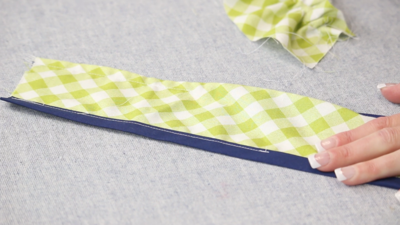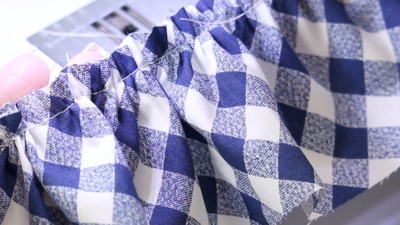How to Prevent Fabric Shrinkage

Learn how to avoid shrinking clothes and other fabric crafts with this handy article!
If you've experienced the horror of your beautiful fabric project shrinking in the wash, you absolutely don't want to do that again. After all, if you've put the time and effort into sewing something, it's all the worse when it gets ruined. You especially don't want this to happen if you've made someone an article of clothing as a gift!
Avoid the devastating nightmare of your project shrinking with the tips and tricks in this article.
Pre-wash the fabric.
The key to preventing fabric shrinkage is pre-washing the fabric. Like the name suggests, pre-washing is when you wash and dry your fabric before you begin any project. There are several benefits for pre-washing your fabric. One, any dye that may bleed will be taken care of when you wash the fabric. Two, washing will remove the chemicals from the fabric that might irritate sensitive skin. Lastly, rather than worrying over how to fix a ruined, shrunken craft, you can start a project with fabric that is already its post-washing size.
Add extra fabric before you begin sewing.
Tip: Prepare for the inevitable shrinkage by adding extra fabric to the length and width of your project before you begin sewing. Then, you can cut to adjust the fabric for your desired dimensions after you wash it.
To pre-wash fabric, complete the following steps:
- Zig zag stitch around the raw edges of the fabric.
- Following the instructions on the fabric’s packaging, wash the fabric.
- Throw in with some towels into the washer for agitation.
- After drying the fabric, press it so that you will get a smooth and even surface for cutting. Ironing and steaming it with a device like the Purple TG1100 Iron will give it a smooth, crisp finish.
Can’t be bothered to pre-wash? Then try some of these anti-shrinkage tips:
- Sometimes, uneven fabric feeding can worsen fabric shrinkage in the wash. Use a walking foot machine or pin your fabric panels while sewing to keep your feeding even.
- Sewing tight stitches on a fabric that does not stretch much will result in puckering. This could lead to the fabric shrinking in the wash. Sewing with longer stitches or using a lighter thread reduce tension can help prevent puckering.
More Resources
Looking for more ideas and information? Check out these additional resources:
- How to Keep Fabric from Shrinking from allfreesewing.com
- How to Keep Fabric from Shrinking When You Sew from the Salrite blog
Contest Rules:
- There is a maximum of one extra entry per person. The extra entry will be based upon a comment left on this post. Duplicate comments are not tallied.
- The winner will be selected at random from the comments on this page and the entries on the contest page.
- The winner will be contacted on the morning of December 26th, 2017.
- Email Address provided in their account (please do NOT leave your email address in the comments--you already provided it when you created your account)
- You have until December 24th, 2017 at 11:59pm EST to leave your comment on this post. Comments posted after that will not be counted.
- Contest open to anyone 18+ in US and/or Canada. Excludes Quebec and Puerto Rico.
How do you keep your projects and garments from shrinking?
Your Recently Viewed Projects
flowergirl
Jul 07, 2018
Most fabrics shrink in the dryer so maybe line drying is a safer option for new fabrics. I'd also wash with salt and some mild detergent to set any running colours but if you bought quality fabric you don't have to worry about this. I've only encountered bleeding with denim. These are all very helpful tips and sticking to prewashing will save your fabric from damage.
SharGO
Dec 16, 2017
I've been sewing for over 55 years and have always pre-washed my fabrics. Not only does pre-washing help with possible shrinkage but it removes sizing (which can "hide" the fact that the fabric may not be of the highest quality) and chemicals. (The article mentions removing chemicals that may irritate sensitive skin. At one time, toxic chemicals, such as, formaldehyde were used. I read an article that said breathing the fumes could result in black lung disease as bad as coal miners would often get. Hopefully, the chemicals used today aren't as toxic but I'm not taking any chances.)
txmlhl 4916988
Dec 15, 2017
I always pre-wash any new material. If it's something I'm not sure about washability - I'll wash in the handwash cycle. thanks.
ronaldburge 032237 2
Dec 14, 2017
I am an older lady who has used these techniques for years and have had no problem with shrinkage or bleeding color!
Wicked
Dec 12, 2017
I cut the corners with a pair of pinking shears then wash with detergent vinegar to set the color. I also add salt as I read somewhere this will help with shrinking and setting the fabric color. I then dry on low heat and iron. No more shrinking ) And bonus ... no running color
kimlennie 9336847
Dec 11, 2017
I'm not a sewer but for garments that I've bought I wash in cold water and hang to dry.
ridiculosity 67303 43
Dec 06, 2017
Almost always pre-wash to prevent the distortion of shrinkage after construction. I've heard there are some who prefer the wrinkled look of quilts that shrink afterward.
aketch
Dec 05, 2017
I try to not use shrinkable materials but if I do, I will always pre shrink. Sometimes an item will have to be spot cleaned only.
annamnewby 9627320
Dec 04, 2017
Last year I made a lap quilt for my daughter, did not prewash. When she washed the quilt the fabrics shrank at different rates the quilt now looks terrible. Have learned my lesson about pre washing.
Marilyn B
Nov 17, 2017
These are all great suggestions, especially if your project will be washed once completed, such as clothing items or pillow covers, or washable pillows. I did not think to zigzag the raw edges first, so I have had to cut off some strings once the new fabric was out of the washer! For projects that won't be washed once done, the stiffness of the fabric may help in its construction. Thanks for sharing the good practical tips!
Report Inappropriate Comment
Are you sure you would like to report this comment? It will be flagged for our moderators to take action.
Thank you for taking the time to improve the content on our site.






![Pill Bottle Crafts: Reuse Pill Bottles [15 Ideas]](http://irepo.primecp.com/2017/06/334076/PILL-BOTTLE-CRAFTS-Header_Category-CategoryPageDefault_ID-2274135.jpg?v=2274135)







